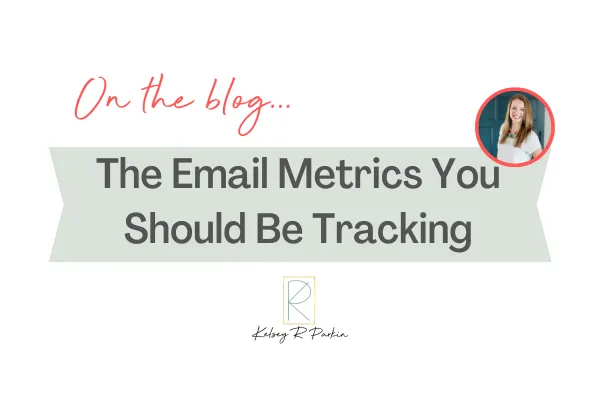Blog
Resources at Your Fingertips

Five Email Metrics You Should Be Tracking
5 Email Metrics You Should be Tracking
Why should you worry about email metrics? Email marketing has long been talked about in the digital marketing world. And despite what some may think, it’s not going away. In fact, email marketing can generate up to $45 for every dollar spent (source). That is a crazy ROI!
Maybe you have been using email in your business, but you haven’t necessarily been seeing a good ROI. Knowing your metrics is the first step in making your email marketing work for you. We will cover our top metrics we use below.

The Email Metric: Click Through Rate (CTR)
What is it?: Click through rate is the number of people who clicked on your messages link as measured by the total number of emails sent out. In other terms, out of all the emails you sent out how many people opened and clicked on a link?
Example: If you send out 100 emails and 5 people click on a link in your email, the click through rate is 5%.
What does it tell you? Why track it: Click through rate can give you a snapshot on how well you did at designing the email itself. Was it engaging for your audience? Did you have good call-to-actions to compel your subscriber to click?
The Goal: The average Click Through Rate is 3-5%
The Email Metric: Click Through to Open Rate (CTOR)
What is it?: Click through to open rate is sometimes a forgotten metric. However, it’s important to track engagement from a different perspective. Click through to open rate combines measures of opens and clicks to give you an idea of overall performance. CTOR is calculated by looking at the # of subscribers who opened the email and dividing it by how many of them actually clicked on something in the email.
Example: You send an email out to 1000 subscribers. Like the example above, 200 people open your email. Of those 200 people 20 people open the link you shared. Your Click Through to Open Rate is 10%.
What does it tell you? Why track it: Click through to open rate measures relevancy. Did you email in fact engage the subscriber enough to take action? Unlike the click through rate, the click through to open rate doesn’t skew your data based on the number of people who did not open your email. CTOR is based only on those who actually laid eyes on your email.
The Goal: The goal for a good CTOR is between 6-15% with an overall average of 10.5%.
The Email Metric: Bounce Rate
What is it?: Bounce rate measures the percentage of emails that are undeliverable to the sender.
Example: You send out 100 emails and 1 email is undeliverable. The bounce rate is 1%.
What does it tell you? Why track it: Bounce rate gives you an overall idea of how healthy your email list is. Are your emails actually making it to active email addresses?
The Goal: The average Bounce Rate for an email list is under 1%
The Email Metric: Unsubscribe Rate
What is it?: Unsubscribe rate measures the percentage of subscribers that unsubscribe when you send out an email.
Example: You send out 100 emails and 1 person unsubscribes. The unsubscribe rate is 1%.
What does it tell you? Why track it: I like to think of the unsubscribe rate as being a measure for two things: the relevance/interest of your list and the amount of value in your email. People are inundated with emails every day. It’s vital that your email provides them value in some way if you want them to stay a subscriber. In addition, having multiple email segments will make sure your emails are getting in front of the right audience.
The Goal: The average unsubscribe rate for an email list is under 1%.
The Email Metric: Email Conversion rate
What is it?: the rate subscribers took a specific action your want to track
Example: You send out 100 emails and 10 people fill out a form you had in your email. The Conversion Rate is 10%.
What does it tell you? Why track it: the Conversion Rate tells you how effective your email or email series is at converting a potential customer. Tracking the Conversion Rate tells you whether your email is really working. Is it worth investing your time in email marketing OR from another angle does your email marketing need to be adjusted to increase your conversion rate.
The Goal: the goal Conversion Rate varies based on the email purpose (e.g. general newsletter conversion rate average is around 1%, where-as order follow up is closer to 5), but in general Email Conversion rate is generally between 2 and 5%.
Why Didn’t Open Rate Make the List?
The most recent iOS 15 update can greatly skew your Open Rate data, but not in the way you would guess. When you send an email through your email service, it attaches a mini code to track whether or not the email gets opened. However with Apple’s update, all recipients on iOS 15 devices register as an open, regardless of whether they took that action. So this actually skews your Open Rate to be higher than what it really is.
Here’s brief info on it just so you know what Open Rate is.
What is it: Open Rate is a percentage that measures unique opens compared to the number of emails delivered. Essentially, it tracks the number of people who actually open your email.
Example: You send an email out to 1000 subscribers and 200 people open your email, the Open Rate is 20%. Here’s why.
In summary,
Those are our top 5 email metrics we like to track at KRP. To get even more information about your email and the ROI, consider using UTM tracking to further determine the effectiveness of your email marketing. You can learn more about UTM Tracking here.
Would you like to start a project with us?
We will help you capture, organize, track and report your data effectively, so you can identify gaps in your business.
Additional Resources
About Us
We crunch the data so you don't have too. Have the data that helps you understand what is moving the needle in your business. If data overwhelms you, we support in finding the story in your data, so data become meaningful for your business.


